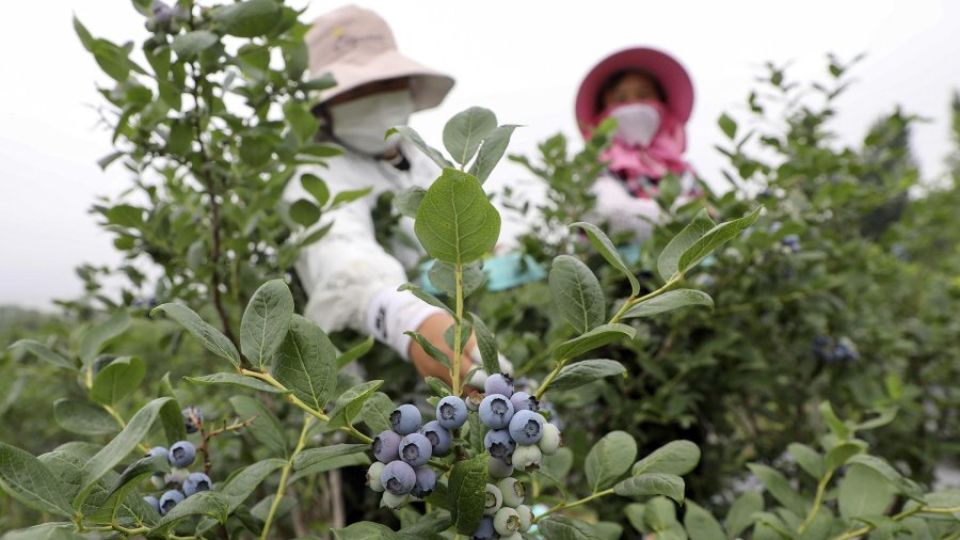
BEIJING (ANN/CHINA DAILY) – Chentuan town in Rizhao, Shandong, underwent a remarkable transformation from its polluting stone mining past to becoming a picturesque haven.
Now boasting the province’s largest blueberry production base, its hills are covered with over 1,660 hectares of blueberry bushes, yielding 8,000 metric tons last year – 30 per cent of Shandong’s total production.
This success mirrors the increasing trend in blueberry production and consumption across China in recent years.
The country surpassed the United States as the world’s largest blueberry producer in 2021, with Guizhou, Liaoning, Shandong, Sichuan and Yunnan provinces being the main blueberry-producing regions, according to a report.
The blueberry market is expected to witness further growth in the years ahead, the 2023 State of the Global Blueberry Industry Report, released by the International Blueberry Organisation, said.
Meanwhile, China is also the world’s leading importer of blueberries, bringing in — mainly from Peru and Chile — 42,847 tons of the blue fruit last year, a year-on-year increase of 45 per cent, the report showed.
China was not a traditional consumer of blueberries.
However, higher standards of living and growing awareness of the health benefits associated with a diverse range of fruits have made consumers increase their intake of blueberries.
About 80 percent of Chinese aged 18 to 35 consumed blueberry-related products, including fresh fruits and processed products, last year, according to iiMedia Research.
“Chinese consumers prefer larger blueberries with relatively higher brix levels (level of sugar, vitamins, minerals, proteins, etc) and longer shelf-life,” said Yao Ming, deputy manager of Yuhai Agricultural Tourism Co Ltd of the Rizhao Agricultural Development Group.
“This preference has led to the cultivation of new blueberry varieties tailored to the domestic market,” said Yao, who has been working in the blueberry business for five years.
It is difficult to expand the blueberry planting area because of strict measures aimed at protecting arable land that is used to grow grain. This makes cultivation of new varieties that can produce a higher quantity of blueberries more important, he added.
To meet these demands, Chentuan has been strengthening its technological research and development capabilities to promote the high-quality development of blueberries from seedling cultivation to production.
SEEDLING BREEDING
Even during winter, the laboratory at the blueberry production, education and research base in Chentuan emanates warmth. Rows of small transparent bottles that house blueberry seedlings are neatly arranged there.
“Seedlings play a crucial role in the success of the blueberry market, so we need to prioritise seedling cultivation,” Yao said.
The town has deepened its cooperation with more than 20 universities and research institutes, including Jilin Agricultural University, to develop core technologies for blueberry cultivation.
In 2022, eight new blueberry varieties were bred and recommended as the top varieties for future planting.
“In our town, the peak harvest season of blueberries is from June to July. Thanks to the new varieties, blueberries can reach the market as early as the end of March,” Yao said, adding that some blueberries planted in the town are available even before the Spring Festival.
Compared to traditional varieties, the new ones are better suited to the local climate, he said.
“The new varieties produce larger and sweeter blueberries, and each plant can yield 10 percent more than traditional varieties,” Yao said.
In a greenhouse in the town, Li Chunlei, who has devoted himself to blueberry cultivation for the past 18 years, was watering blueberry seedlings in mid-December. These seedlings are the new varieties that they are trying to cultivate.
“Breeding new varieties is a slow and meticulous process that requires patience. It typically takes seven to eight years to cultivate a new variety,” said Li.
Li and his colleagues planted more than 200 new varieties of blueberry seedlings in the greenhouse last March. After observing their growth and comparing the results, they eliminated more than 40 seedlings.
Chentuan has also adopted technological advancements in planting blueberries.
At a blueberry industrial park, all 95 standard blueberry greenhouses are equipped with a smart internet of things platform.
Sensors in the greenhouses upload data, such as temperature, soil moisture, and humidity to the platform, allowing blueberry growers to monitor real-time soil and air temperatures.
The blueberry IoT information management and control system also provides quick access to information on agricultural diseases, pests and disasters in the park.
“Standardised cultivation has significantly improved the quantity, quality and fruit safety of blueberries,” said Yao.

INDUSTRIAL SHIFT
Chentuan is located at the upper basin of Rizhao’s biggest reservoir, which supplies water for both production and daily use in the city.
A decade ago, the stone mining and processing industry was a major contributor of revenue to the local government, with an annual output value of around CNY120 million (USD16.76 million).
However, the industry posed risks to safe drinking water and the physical health of residents.
Local statistics show that stone processing in Chentuan produced over 100,000 cubic metres of slurry and sawdust each year.
To address these issues, local government departments adopted various measures.
They assisted stone business units that wished to continue their operations in relocating to a stone industrial park and guided those who wanted to transition away from the business to explore new opportunities, such as growing blueberries.
In 2014, all stone extraction and processing facilities in Chentuan were shut down. Since then, the town’s environmental quality has steadily improved, creating a positive atmosphere for blueberry cultivation.
“As early as in 2005, an agricultural professor from Dalian University planted some blueberries in a village of our town because the soil of the hills suits the growth of blueberries,” said Yao.
Two years later, the blueberry saplings produced a good harvest and were sold out quickly.
“When local government departments shut down the stone business, they started to guide local farmers in expanding the growing area of blueberry as an option to enrich the local people,” said Yao.
“I work at a blueberry production base from March to July harvesting open field blueberries, earning a decent income,” said Wang Peiyun, a resident of Dongshidun village.
The blueberry industry has provided a large number of jobs for villagers in the town. During the annual harvest season alone, it creates jobs for over 10,000 farmers.
Thanks to the blueberry industry, the per capita bank deposits in the town, which now has a permanent population of 19,000, had increased from CNY18,000 in 2012 to CNY80,000 in 2022, said the township government.
“We will establish a complete industry chain, from seedling breeding to deep processing, and promote the integrated development of the agricultural and tourism sectors to contribute to rural vitalisation,” said Feng Pengzhan, head of the township government.




